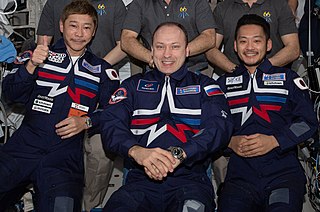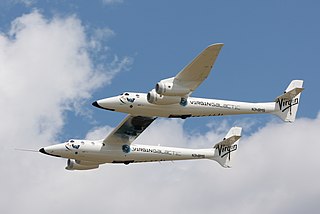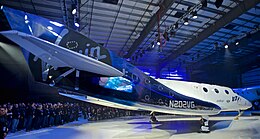
Space tourism is human space travel for recreational purposes. There are several different types of space tourism, including orbital, suborbital and lunar space tourism.

Virgin Galactic Holdings, Inc. is an American spaceflight company founded by Richard Branson and the Virgin Group conglomerate which retains an 11.9% stake through Virgin Investments Limited. It is headquartered in California, and operates from New Mexico. The company is developing commercial spacecraft and aims to provide suborbital spaceflights to space tourists. Virgin Galactic's suborbital spacecraft are air launched from beneath a carrier airplane known as White Knight Two. Virgin Galactic's maiden spaceflight occurred in 2018 with its VSS Unity spaceship. Branson had originally hoped to see a maiden spaceflight by 2010, but the date was delayed for several years, and then delayed again, primarily due to the October 2014 crash of VSS Enterprise.

Air launching is the practice of releasing a rocket, missile, parasite aircraft or other aircraft payload from a mother ship or launch aircraft. The payload craft or missile is often tucked under the wing of the larger mother ship and then "dropped" while in flight. It may also be stored within a bomb bay, beneath the main fuselage or even on the back of the carrier aircraft, as in the case of the D-21 drone. Air launching provides several advantages over ground launching, giving the smaller craft an altitude and range boost, while saving it the weight of the fuel and equipment needed to take off on its own.

VSS Enterprise was the first SpaceShipTwo (SS2) spaceplane, built by Scaled Composites for Virgin Galactic. As of 2004, it was planned to be the first of five commercial suborbital SS2 spacecraft planned by Virgin Galactic. It was also the first ship of the Scaled Composites Model 339 SpaceShipTwo class, based on upscaling the design of record-breaking SpaceShipOne.

The Scaled Composites Model 339 SpaceShipTwo (SS2) is an air-launched suborbital spaceplane type designed for space tourism. It is manufactured by The Spaceship Company, a California-based company owned by Virgin Galactic.

The Scaled Composites Model 348 White Knight Two (WK2) is a quadjet cargo aircraft that is used to lift the SpaceShipTwo spacecraft to release altitude. It was developed by Scaled Composites from 2007 to 2010 as the first stage of Tier 1b, a two-stage to suborbital-space crewed launch system. WK2 is based on the successful mothership to SpaceShipOne, White Knight, which itself is based on Proteus.

A commercial astronaut is a person who has commanded, piloted, or served as an active crew member of a privately funded spacecraft. This is distinct from an otherwise non-government astronaut, for example Charlie Walker, who flies while representing a non-government corporation but with funding or training or both coming from government sources.

VSSUnity, previously referred to as VSS Voyager, is a SpaceShipTwo-class suborbital rocket-powered crewed spaceplane. It is the second SpaceShipTwo to be built and is part of the Virgin Galactic fleet. It first reached space as defined by the United States on 13 December 2018, on the VP-03 mission.

The VSS Enterprise crash occurred on October 31, 2014, when the VSS Enterprise, a SpaceShipTwo experimental spaceflight test vehicle operated by Virgin Galactic, suffered a catastrophic in-flight breakup during a test flight and crashed in the Mojave Desert near Cantil, California. Co-pilot Michael Alsbury was killed and pilot Peter Siebold was seriously injured.

The billionaire space race is the rivalry among entrepreneurs who have entered the space industry from other industries - particularly computing. This private spaceflight race involves sending privately developed rockets and vehicles to various destinations in space, often in response to government programs or to develop the space tourism sector.

VP-03 was a sub-orbital spaceflight of the SpaceShipTwo-class VSS Unity which took place on 13 December 2018, piloted by Mark P. Stucky and co-piloted by Frederick W. "CJ" Sturckow.

Mark P. "Forger" Stucky is an American test pilot and commercial astronaut. In these roles, he was an employee of Virgin Galactic, a private spaceflight company which is developing sub-orbital space tourism flights.

Beth Moses is chief space flight participant instructor and interiors program manager for Virgin Galactic's SpaceShipTwo program, and is a commercial astronaut, as classified by the Federal Aviation Administration. She was the first woman to make a spaceflight on a commercially launched vehicle, the VSS Unity VF-01 flight of 22 February 2019. She was also part of the six-member crew that flew in the first fully-crewed test flight to space on July 11, 2021, aboard VSS Unity.

VF-01 was a sub-orbital spaceflight of the SpaceShipTwo-class VSS Unity that took place on 22 February 2019, piloted by David Mackay and co-piloted by Mike Masucci. It was operated by Virgin Galactic, a private company led by Richard Branson that intends to conduct space tourism flights in the future. Following VSS Unity VP-03, VF-01 was a demonstration of the craft's ability to carry passengers. Virgin Galactic's chief astronaut trainer Beth Moses acted as a test passenger, evaluating the experience for potential customers.

Virgin Galactic Unity 21 was a sub-orbital spaceflight of the SpaceShipTwo-class VSS Unity which took place on 22 May 2021, piloted by David Mackay and co-piloted by Frederick Sturckow. It was the first human spaceflight from the state of New Mexico. It was operated by Virgin Galactic, a private company led by Richard Branson which intends to conduct space tourism flights in the future. Unity 21 was the first human spaceflight to be launched from Spaceport America.
Sirisha Bandla is an Indian-American aeronautical engineer. She is the Vice President of Government Affairs and Research Operations for Virgin Galactic. She flew on the Virgin Galactic Unity 22 mission which made her the second India-born woman to go to space and the fourth person of Indian descent ever to go past the line of space after Rakesh Sharma, Kalpana Chawla and Sunita Williams.

Galactic 01, previously referred to as Unity 23, was a sub-orbital spaceflight of the SpaceShipTwo-class VSS Unity which launched on 29 June 2023. The launch was the first commercial spaceflight for Virgin Galactic. A research mission for the Italian Air Force, the crew consisted of pilots Michael Masucci and Nicola Pecile as well as crew members Colin Bennett, Walter Villadei, Angelo Landolfi, and Pantaleone Carlucci. The flight was postponed from its original planned October 2021 flight date for Virgin Galactic to upgrade its SpaceShipTwo vehicles.

Virgin Galactic Unity 25 was a sub-orbital spaceflight by Virgin Galactic that took place on 25 May 2023. The flight used their SpaceShipTwo spaceplane VSS Unity. The crew consisted of six Virgin Galactic employees. Unity 25 was the first spaceflight for the company since Unity 22 in 2021, when founder Richard Branson flew to space.











